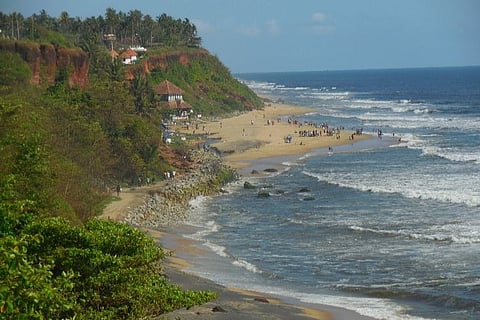

Standing at the edge of a rugged line of laterite cliffs that plunged dramatically down to the silvery beaches, I had a wide-angle view of the turquoise waters stretching into the horizon. Though not as flashy as Kovalam, Varkala has something for everyone. Its beaches, temples, forts, history, scenic charm, myths and mythology continue to draw nature enthusiasts and heritage buffs, beachcombers and backpackers, the spiritually inclined and the solitude chasers. From a temple town, it has metamorphosed into a popular hangout for outdoor lovers and adventure junkies. The town is also famed for its natural springs with therapeutic qualities and a centre for Ayurvedic treatment and yoga. I was awed by the quietude, tranquillity and unique ambience of this beach retreat.
The sacred temples and blessed waters lend a sublime aura to Varkala, which is a significant pilgrimage centre for the people of Kerala. Sauntering along the Papanasam Beach, I stopped to listen to the resounding drone of ritual mantras chanted by priests and repeated by mourners almost drowned by the frolicking sea. On Karkidaka Vavu (the new moon in August), hordes of people throng here to perform the annual rites for departed relatives. They also believe that their sins will be washed away by Papanasam’s holy waters. Later I scrambled on to the wide plateau atop the laterite cliffs beside the beach. Lounging at this vantage point of the majestic sea cliff-top, I enjoyed the glorious sunset. There are other beaches like Thiruvambadi Beach at Varkala’s northern end and Southern Cliff, which is home to the surf school and yoga retreat.

Clambering up a flight of steps, I reached the more than 2,000-year-old Janardhana Swamy temple located at the entrance of the beach road. It is the only temple where Lord Vishnu is worshipped in the form of Janardhana. In its vicinity is the temple tank fed by a perennial spring. The temple features typical Kerala architecture, with a circular building housing the main shrine, and sprinkled with sculptures of deities. The square mandapam with navagrahas carved on the wooden ceiling and the ancient brass bells gifted by a mariner are equally impressive.

According to a legend that gave Varkala its name, sage Narada was approached by mendicants who confessed to having sinned. Narada flung his valkalam (garb made out of the bark of a tree) into the air, and the place where it landed came to be known as Valkala. At this precise spot, a temple was consecrated to Lord Vishnu. Hence Varkala is believed to be a corruption of Valkala. The mendicants were directed to offer prayers for their redemption by the seashore, which came to be known as Papanasam Beach or the ‘Beach of Redemption.’
From the temple, we headed to Sivagiri Mutt, the final resting place of Sree Narayana Guru, a great social reformer who advocated ‘one caste, one religion, one god for mankind.’ I strolled in the sprawling expanse of greenery, savouring the silence and meditative calm of the samadhi of the guru in the sacred grounds situated atop a hillock. I had a peek into the guru’s residence, where his humble belongings are on display.

I ventured south, to the fishing hamlet of Anjuthengu (meaning ‘five coconut trees’). Popularly known by its abbreviated name Anjengo, it is a strip of land sandwiched between the sea and the backwaters. Built by the Portuguese in 1695, every stone in Anjengo Fort resonates with a tale of previous regimes, long consigned to history. It originally served as the first signalling station for ships arriving from England and was used as a merchandise and ammunition depot by its builders.

I saw the ruins of an ancient factory, a 130-feet tall lighthouse, and Varkala Canal, a dilapidated masonry canal with big openings in the roof for ventilation that exhibits rare engineering expertise. In times of yore, the canal was used to ferry boats between Kollam and Thiruvananthapuram.

From the fort, I took a detour to the makeshift jetty at Nedunganda village and punted down in a country boat to the uninhabited isle of Ponnuthuruthu, surrounded by the Anjengo backwaters. I walked to the century-old temple dedicated to Shiva and Parvathy ensconced amidst dense coconut groves. I was surprised to discover that the queens of the Travancore royal family used to visit the temple and hide their precious jewellery on the island for safekeeping and hence the name Ponnuthuruthu, meaning ‘Golden Island’.

Kappil, a secluded and stunning spot, was the last stop on my itinerary. I soaked in the stunning views of the dramatic confluence of the Arabian Sea, the Kappil river and the placid backwaters near Kappil Beach. A boat ride took me past tiny, palm-covered islets within the estuary. The place is amazing, with the coastal road passing through this area for a long stretch – a golden sand beach on one side of the road and on the other, the tranquil estuary and palm-fringed backwaters. I returned contented because I had reserved the best for the last.
All photographs by Susheela Nair.
Susheela Nair is an independent food, travel and lifestyle writer, and photographer based in Bangalore. She has contributed content, articles and images on food, travel, lifestyle, photography, environment, and ecotourism to several reputed national publications. Her writings constitute a wide spectrum which also includes travel portals and guide books, brochures and coffee table books.